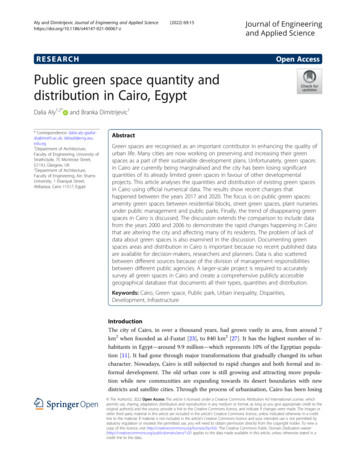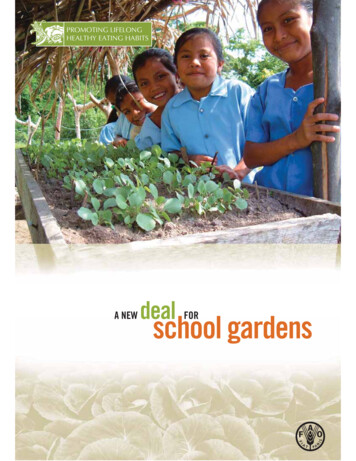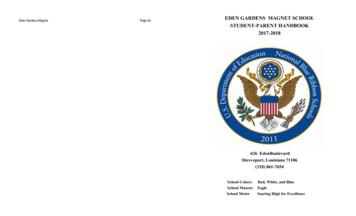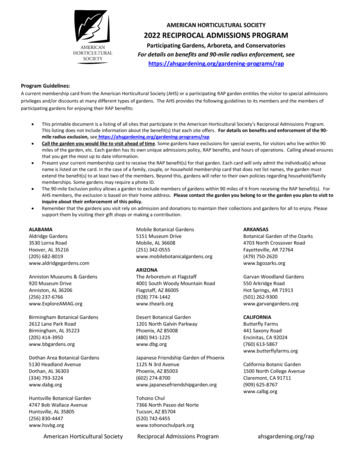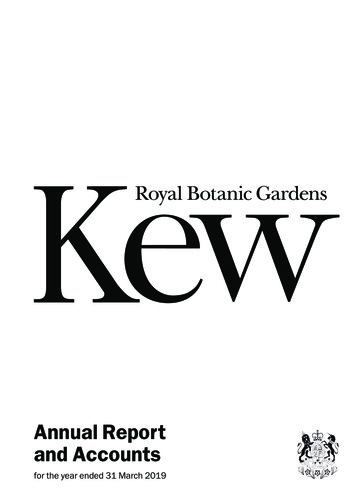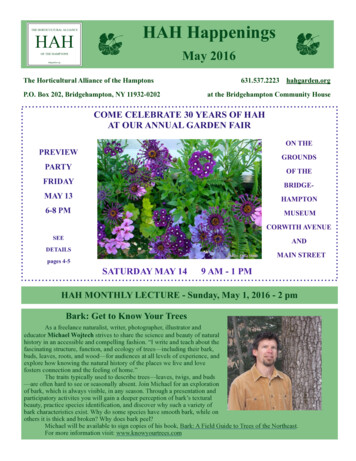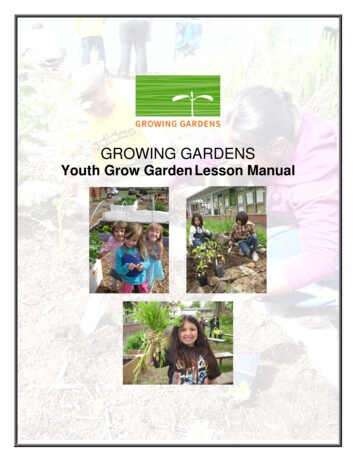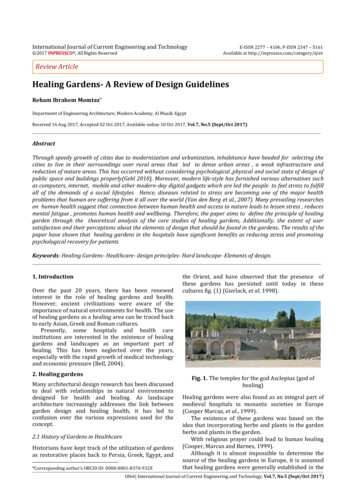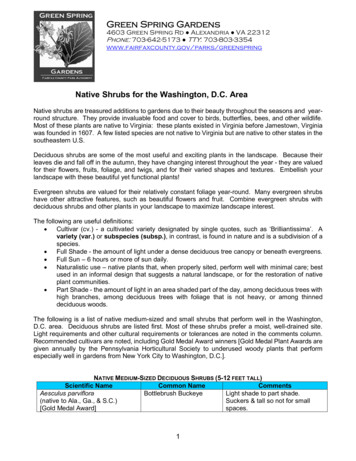
Transcription
Green Spring Gardens4603 Green Spring Rd Alexandria VA 22312Phone: 703-642-5173 TTY: gNative Shrubs for the Washington, D.C. AreaNative shrubs are treasured additions to gardens due to their beauty throughout the seasons and yearround structure. They provide invaluable food and cover to birds, butterflies, bees, and other wildlife.Most of these plants are native to Virginia: these plants existed in Virginia before Jamestown, Virginiawas founded in 1607. A few listed species are not native to Virginia but are native to other states in thesoutheastern U.S.Deciduous shrubs are some of the most useful and exciting plants in the landscape. Because theirleaves die and fall off in the autumn, they have changing interest throughout the year - they are valuedfor their flowers, fruits, foliage, and twigs, and for their varied shapes and textures. Embellish yourlandscape with these beautiful yet functional plants!Evergreen shrubs are valued for their relatively constant foliage year-round. Many evergreen shrubshave other attractive features, such as beautiful flowers and fruit. Combine evergreen shrubs withdeciduous shrubs and other plants in your landscape to maximize landscape interest.The following are useful definitions: Cultivar (cv.) - a cultivated variety designated by single quotes, such as ‘Brilliantissima’. Avariety (var.) or subspecies (subsp.), in contrast, is found in nature and is a subdivision of aspecies. Full Shade - the amount of light under a dense deciduous tree canopy or beneath evergreens. Full Sun – 6 hours or more of sun daily. Naturalistic use – native plants that, when properly sited, perform well with minimal care; bestused in an informal design that suggests a natural landscape, or for the restoration of nativeplant communities. Part Shade - the amount of light in an area shaded part of the day, among deciduous trees withhigh branches, among deciduous trees with foliage that is not heavy, or among thinneddeciduous woods.The following is a list of native medium-sized and small shrubs that perform well in the Washington,D.C. area. Deciduous shrubs are listed first. Most of these shrubs prefer a moist, well-drained site.Light requirements and other cultural requirements or tolerances are noted in the comments column.Recommended cultivars are noted, including Gold Medal Award winners [Gold Medal Plant Awards aregiven annually by the Pennsylvania Horticultural Society to underused woody plants that performespecially well in gardens from New York City to Washington, D.C.].NATIVE MEDIUM-SIZED DECIDUOUS SHRUBS (5-12 FEET TALL)Scientific NameCommon NameCommentsAesculus parvifloraBottlebrush BuckeyeLight shade to part shade.(native to Ala., Ga., & S.C.)Suckers & tall so not for small[Gold Medal Award]spaces.1
Aronia arbutifolia &‘Brilliantissima’ [Gold MedalAward]Red ChokeberryAronia melanocarpa – a small tomedium-sized shrub, dependingon the selection.Iroquois Beauty (‘Morton’) hasperformed well. New cultivarsbeing tested at Green Spring:Lo Scape Hedger('UCOBNNAM166') &Lo Scape Mound('UCONNAM165')Black ChokeberryNote: A. prunifolia(A. floribunda; purple chokeberry)is a natural hybrid of the abovespecies. It is harder to purchase(supposedly taller plants but someplants at Green Spring have beenshort).Callicarpa americanaCalycanthus floridus(’Michael Lindsey’ won GoldMedal Award but have not seenfor sale. Other fragrant cultivarsinclude ‘Edith Wilder’ &‘Big George’.)Clethra alnifolia – species is whiteflowered.American BeautyberryEastern Sweetshrub,Carolina AllspiceSummersweetFull sun to light shade;consistently moist to wet sitesbest. Slowly suckers.Full sun to light shade; toleratesdry sites. Grown for light purplefruit in the fall.Light shade to part shadeFull sun to part shade; moist towet sites best. Slowly suckers.Also pink flowered cultivars & thedarkest pink is ‘Ruby Spice’ [GoldMedal Award]; lighter pinks are‘Fern Valley Pink’ & ‘Rosea’.Note: ‘Sixteen Candles’ performswell in some locations & not inothers (seems to like consistentlymoist sites).Shorter cultivars:‘Hummingbird’[Gold Medal Award; the toughestshort cultivar],Sugartina ('Crystalina'), &Vanilla Spice (‘Caleb’).Vanilla Spice ('Caleb') leafs outlater than the others so be patient& don’t cut it back.The species itself & most cultivarsare medium-sized.2
Cornus amomum - young stemsare not colorful in the winter as isthe species belowSilky DogwoodFull sun to light shade; toleratewet soils; dogwood sawfly is aproblem in some sites.C. sericea(‘Hedgerows Gold’ is variegated)- usually colorful stems in thewinter for the species & cultivars(keep renewal pruning)Redosier DogwoodCyrilla racemiflora(for the native plant collector;some small forms also availablebut not very attractive in our area)Fothergilla ‘Mount Airy’(cross of F. gardenii x F. major;both species are native to NC &further south) [Gold Medal Award]Swamp Cyrilla,Swamp TitiFor C. sericea to produce colorfulwinter stems - renewal pruneyearly for best winter stem color(no more than 1/3 of the stemsremoved in a given year – pruneout oldest stems). ’Cardinal’ doesnot have good winter color in ourarea compared to up north whereit was selected.Full sun to light shade; prefersmoist to wet soils. Interestingspecies with twisting branches.Hydrangea quercifolia(native to Tenn. & severalsoutheastern states)Taller cultivars:*Snowflake (‘Brido’) - doubleflowered white (no value topollinators)*Snow Queen (‘Flemygea’)[Gold Medal Award] –single-flowered whiteOakleaf HydrangeaHybrid FothergillaFull sun to part shade in moistsites.Note: The parents of this crosshave been harder to grow atGreen Spring: Fothergilla gardeniiis smaller & needs consistentlymoist sites. F. gardenii ‘Suzanne’is compact, has excellent flowers,& good fall color.Light shade to full shade. Bloomson old wood so best to prune afterflowering if needed (seldom needspruning).Little Honey (‘Brihon’) is a yellowleaf selection of ‘Pee Wee’. ‘PeeWee’ has not performed well indrier sites in the past – both ‘PeeWee’ & Little Honey at GreenSpring are grown in locations withhigher than average irrigationlevels.Many other cultivars are available.Shorter cultivars:‘Ruby Slippers’ - flowers openwhite & transition from pink torose‘Sikes Dwarf’ - white flowers(short for several years &eventually medium-sized)3
Ilex verticillata & cultivars:‘Scarlett O’Hara’[Gold Medal Award].Male pollinator is ‘Rhett Butler’.Winterberry HollyThe wild type of Ilex verticillata,can eventually grow to be a largeshrub & fruit is more palatable tobirds (so disappears faster).[‘Winter Red’ & ‘Winter Gold’ both won a Gold Medal Award]Male pollinator for ‘Winter Red’ &‘Winter Gold’ is‘Southern Gentleman’ (pollinatorfor southern type, fast-growingcultivars).‘Red Sprite’ (‘Nana’) is a shortcultivar that likes moist to wetsites [Gold Medal Award].Lindera benzoinMyrica pensylvanica orMorella pensylvanicaNote: M. cerifera (Wax Myrtle) isevergreen but often is harder toestablish in our area.Physocarpus opulifolius &cultivars:Gold leaves: ‘Dart’s Gold’ &‘Nugget’Full sun to part shade; best inmoist to wet sites (fruits better withmoisture & sun).Newer cultivars under evaluationinclude Berry Poppins('FarrowBPop'; reported to be3 - 4 ft tall), & Mr. Poppins('FarrowMrP') is the pollinator.SpicebushNorthern BayberryNinebarkLight shade to part shade - moistsites best (good fall color inshade)Full sun; salt tolerant; tolerates drysites but dieback after some verydry years; can be hard to establishplants in some sites. Have nothad luck with dwarf cultivars.Full sun to light shade; speciestype is best for naturalistic use;tolerant of dry sites (especially inlight shade) but looks best in moistsites.Purple leaves:Diabolo (‘Monlo’)[Gold Medal Award; Diablo is asynonym] &Summer Wine (‘Seward’; slightlyshorter cultivar)Popular now that have cultivarswith colorful leaves.Purple leaves with a bit of goldin the middle:‘Center Glow’Coppery leaves in spring &reddish in summer:Coppertina (‘Mindia’)New supposedly shorter cultivarsavailable but have not grown(have smaller leaves) –’Little Devil’ & ‘Tiny Wine’.4
Rhododendron - deciduousazalea species native to Virginia:R. arborescens(Species is white to rose colored;growth can be very slow. A pinkflowered form has been morevigorous in gardens.‘Pink and Sweet’ is aR. arborescens x R. arborescenshybrid)Sweet AzaleaR. calendulaceum & cultivars(native to southern portion ofVirginia in mountains so give bestgrowing conditions)Flame AzaleaR. periclymenoides(one of the best performers inaverage sites in our area)Pinxterbloom AzaleaR. prinophyllum (‘Marie Hoffman’has bloomed well but looks like itmight be a hybrid)Roseshell AzaleaR. viscosum & cultivars(‘Lemon Drop’ is slightly fragrant –some forms are very fragrant.‘Betty Cummins’ looks promising.)Rhododendron atlanticum &hybrids (often shorter plants thanthe above species) –One shorter cultivar is ‘Marydel’(cross of R. atlanticum &R. periclymenoides).‘Choptank Yellow’ has the sameparentage but a different flowercolor. A similar cross at GreenSpring originally found in the wildis medium-sized.Rhododendron - deciduousazalea species native to othersoutheastern states & some oftheir cultivars:R. alabamense (native to Tenn.&other southeastern states)Swamp AzaleaCoast Azalea & HybridsLight shade to part shade. Mostprefer moist sites – of this groupR. periclymenoides is the mosttolerant of dry sites.R. arborescens & R. viscosum likemore moisture (moist to at leastperiodically wet sites).Note: ‘White Lightning’ is ashowy natural hybrid ofR. arborescens withR. calendulaceum orR. cumberlandense.Light shade to part shade;Some tolerance of dry sites.These hybrids often occurnaturally in the wild. TheChoptank hybrids were originallyselected from natural populationsin the Maryland & Delawareborder area. Other hybridcultivars include ‘Choptank Rose’& ‘Rosy Cheeks’.Of this group R. alabamense hasbeen the most tolerant of dry sitesbut prefers moist sites.Alabama AzaleaR. austrinum & cultivars(native from Ga. to Miss.) –frequently used to create hybridcultivarsFlorida AzaleaR. flammeum & cultivars (native toGA & SC) - bloomed well butvery short so far (eventuallysupposed to be medium-sized)Onocee Azalea5Some R. austrinum plants havehad winter kill on some branchesfollowing dry summers & coldwinters.Green Spring is evaluating hybridsof many species as well.‘Coleman’s Early Yellow’ ispossibly a hybrid of R. austrinum& R. alabamense. ’My Mary’ is ahybrid of 3 native species.
Rhus aromaticaFragrant SumacFull sun; tolerate dry sites;suckersR. copallinumShining SumacR. glabraSmooth SumacR. typhina & cultivars:‘Dissecta’ (‘Laciniata’) &Tiger Eyes [‘Bailtiger’ –Gold Medal Award; golden foliage& more compact than the species]Staghorn SumacViburnum dentatum - native formstend to have red-yellow fall color,while Red Feather (‘JN Select’)has red-purple fall color.Arrowwood ViburnumV. nudum (var. nudum) Brandywine (‘Bulk’) &‘Winterthur’ [Gold Medal Award]Smooth Withe-rodViburnum,Possumhaw ViburnumFull sun to part shade. Likes moistto wet sites.A native species best fornaturalistic use:V. acerifoliumMapleleaf ViburnumLight shade to part shade; not astough as some species over time(has declined over time so morefor native plant collectors – deer &drought problems at GreenSpring).The species type of R. typhina,R. copallinum, & R. glabra canbecome large shrubs.Deer damage the trunks of largeplants in the rut (breeding season)– may need protect the bark inareas with deer with plastic meshprotectors or cages.Full sun to light shade; tolerate drysites. Blue Muffin (‘Christom’;reported to be smaller than thespecies type but just grows moreslowly when young; yellow fallcolor).Note: Viburnums are generallyself-incompatible & need twoplants of the same species withdifferent genetic backgrounds toproduce fruit.Medium-sized Native Shrubs Best for Naturalistic Use or Special Habitat Uses:Alnus serrulata (Smooth Alder) - wetlands & wet areas. Other native species also available fromnative plant nurseries.Amelanchier spicata or A. stolonifera (Running Serviceberry) - wildlife gardeningCephalanthus occidentalis (Buttonbush) – consistently moist or wet soils; full sun best. Testing shortercultivar ‘Sugar Shack’. Excellent plant for adult butterflies.Corylus americana & C. cornuta (Hazelnut) - wildlife gardening but loved by deer to the point that theycan kill it.Euonymus americana (American Euonymus, Bursting Heart) & E. atropurpurea (Eastern Wahoo; caneventually become a large shrub)Rosa carolina, R. palustris, & R. virginiana (Native Roses) – often sucker extensively & many thornsSambucus nigra subsp. canadensis (S. canadensis) (American Elderberry) - wildlife gardening6
NATIVE SMALL DECIDUOUS SHRUBS (2-5 FEET TALL)Scientific NameCommon NameCommentsHydrangea arborescens (lacecap Smooth HydrangeaSpecies type is loved by deer.flowers) & cultivars.Blooms on new wood so can‘Annabelle’ [Gold Medal Award;prune in the spring.double white flowers].Note: newer introductions with‘Invincibelle Ruby’ is a doublelacecap type flowers are not in theflowered cultivars that looksGreen Spring collection, such aspromising.‘White Dome’.Itea virginicaVirginia SweetspireFull sun to part shade; tolerant ofTaller cultivars includewet or dry sites; suckers slowly.‘Henry’s Garnet’ [Gold MedalAward], ‘Longspire’, ‘Sarah Eve’,‘Henry’s Garnet’ has the excellent& ‘Saturnalia’.fall color. Little Henry has nice fallcolor in good sites.Little Henry (‘Sprich’) is a shortcultivar & vigor is too low in somelocations – seems to like moist,loamy soils best.Gro-Low SumacFull sun to light shade; toleratesRhus aromatica ‘Gro-Low’(the species itself is usuallydry sites. Grown mostly formedium-sized)beautiful red fall color & groundcover habit in dry sites.Spiraea alba (var. latifolia)White MeadowsweetFull sun in consistently moist sitesbest.Note: Native species are grownprimarily by native plant lovers &Other species found in Virginiato attract butterflies – generally(S. tomentosa ¬ as showy as Asian species &S. virginiana) like consistentlycultivars.moist to wet sites. S. virginiana(Virginia Spiraea) is endangeredin the wild & difficult to purchase.Symphoricarpos orbiculatusCoralberryFull sun & tolerant of dry sites;spreads by suckers. Good wildlifeplant.Small Native Shrubs Primarily for Naturalistic Use, Special Habitat Uses, or Fruit Production:Diervilla lonicera & Diervilla sessilifolia (Diervilla, Bush Honeysuckle). Diervilla sessilifolia is native toNC & further south – testing Kodiak Black ('SMNDRSF'). Have not tested variegated D. sessilifoliaCool Splash ('LPDC Podaras') but may be useful to gardeners who like white variegated foliage intheir borders.Vaccinium stamineum (Deerberry; fruit not eaten by humans) &V. corymbosum (Highbush Blueberry; fruit delicious to humans – the blueberry we most commonlyeat; likes acid, moist to periodically wet sites, & prefers sandier or rockier soils; fruits better in full sun)Zenobia pulverulenta (Dusty Zenobia) - blue-leaved forms are available but were harder to grow atGreen Spring.NATIVE MEDIUM-SIZED EVERGREEN SHRUBS (5-12 FEET TALL)Illicium floridanum (native to Fla.,Florida Anise-TreeLight shade to part shadeGa., & other southeastern states)‘Halley’s Comet’ [Gold MedalAward]7
Juniperus ‘Grey Owl’ (at least someparentage is the nativeJ. virginiana)Kalmia latifolia(many cultivars are available ‘Olympic Fire’, ‘Pristine’, & ‘YankeeDoodle’ have been the bestperformers at Green Spring)Grey Owl JuniperFull sun; tolerates dry sites; a femaleform with blue conesMountain LaurelRhododendron maximumRosebay RhododendronThuja occidentalis - dwarf &slow growing cultivarsDwarf & Slow GrowingEastern ArborvitaeCultivarsLight shade to part shade; best innaturally moist sites with gooddrainage – doesn’t like a lot ofoverhead irrigation (disease problems).The shorter cultivars didn’t haveenough vigor to perform well.Light shade to part shade in moist siteswith good drainageFull sun to light shade; tolerates drysitesGold cultivars: ‘Sunkist’ & the tallerTechny Gold ('Walter Brown') –both 10 – 15 ft. tallGreen Cultivars: ‘Hetz Midget’ is asmall cultivar (3-4 ft), as is‘Umbraculifera’. ‘Filiformis’ growsslowly to 6 ft.'Emerald' ('Smaragd') grows slowlyto 15 ft tall - fairly narrowNATIVE SMALL EVERGREEN SHRUBS (2-5 FEET TALL)Ilex glabra cultivars:Inkberry HollyFull sun to light shade in moist orSome of the best includeperiodically wet sites. The speciesNordic (‘Chamzin’) & ‘Shamrock’type is taller & for naturalistic use.(the most compact form)I. opaca ‘Maryland Dwarf’ &'Clarendon Spreading' ('Clarendon')Leucothoe fontanesiana(best to grow the species type cultivars that were tested at GreenSpring were more disease prone)Dwarf American HollyCulitvarsDrooping LeucothoeNote: L. axillaris (Coast Leucothoe)likes more consistent moisture –has done well not far fromTurkeycock Run at Green SpringPinus strobus dwarf & slow growing Dwarf & Slow Growingcultivars such as ‘Blue Jay’,Eastern White Pine‘Horsford’, & ‘Merrimack’ Cultivarsmostly for plant collectors who canprovide the right growing conditions.8Full sun to part shade; tolerates drysitesLight shade to part shade in moistsitesFull sun. Were good performers onwell-drained, north-facing slope atGreen Spring & the Rock Garden, butin level sites these dwarf forms havedied when fairly young (fungalpathogens). Snow damage in yearswith heavy snow sometimes is tooextensive so they were removed.
Scientific Names Of Plants - Current Names Are From: Encyclopedia of Life (http://eol.org/) – institutional partners include Harvard University, theMissouri Botanical Garden, the Smithsonian Institution, and The Field Museum. Tropicos from the Missouri Botanical Garden (http://tropicos.org/)If a second scientific name is given, it is usually an old name that is still seen in some references orused by some nurseries. However, the above databases do not always agree on names.Other References: Flora of Virginia. Alan Weakley, J. Christopher Ludwig, and John Townsend. 2012. BRIT Press.Botanical Research Institute of Texas.The Kemper Center for Home Gardening Plantfinder at the Missouri Botanical Garden is anexcellent reference for plant names, gardening information, and /plantfinder/plantfindersearch.aspx).It features plants in their Kemper Center display gardens and is an excellent website aboutornamental plants.Landscaping With Native Plants. Maryland Native Plant This booklet is also available in print form.The Lady Bird Wildflower Center at the University of Texas in Austin has developed the Native PlantInformation Network for native plants (http://www.wildflower.org/explore/).Native Plants for Northern Virginia (http://www.plantnovanatives.org/). This booklet is also availablein print form. It is a publication of the Plant NoVA Natives initiative, which includes the Virginia NativePlant Society.USDA PLANTS Database (http://plants.usda.gov/java/) - this database focuses on plants native tothe U.S. and to U.S. Territories and Protectorates, as well as naturalized non-natives and invasives. Itis also used to determine distribution within Virginia by county.Developed by Brenda Skarphol,Curatorial Horticulturist at Green Spring GardensRevised 9-5-16A publication ofFairfax County, VA9/2016For ADA accommodations and/or alternative formats,please call 703-324-8563 at least 10 working days in advance of the event. TTY 703-803-33549
'Ruby Slippers' -flowers open white & transition from pink to rose 'Sikes Dwarf' -white flowers (short for several years & eventually medium-sized) Oakleaf Hydrangea : Light shade to full shade. Blooms on old wood so best to prune after flowering if needed (seldom needs pruning). Little Honey ('Brihon') is a yellow-
